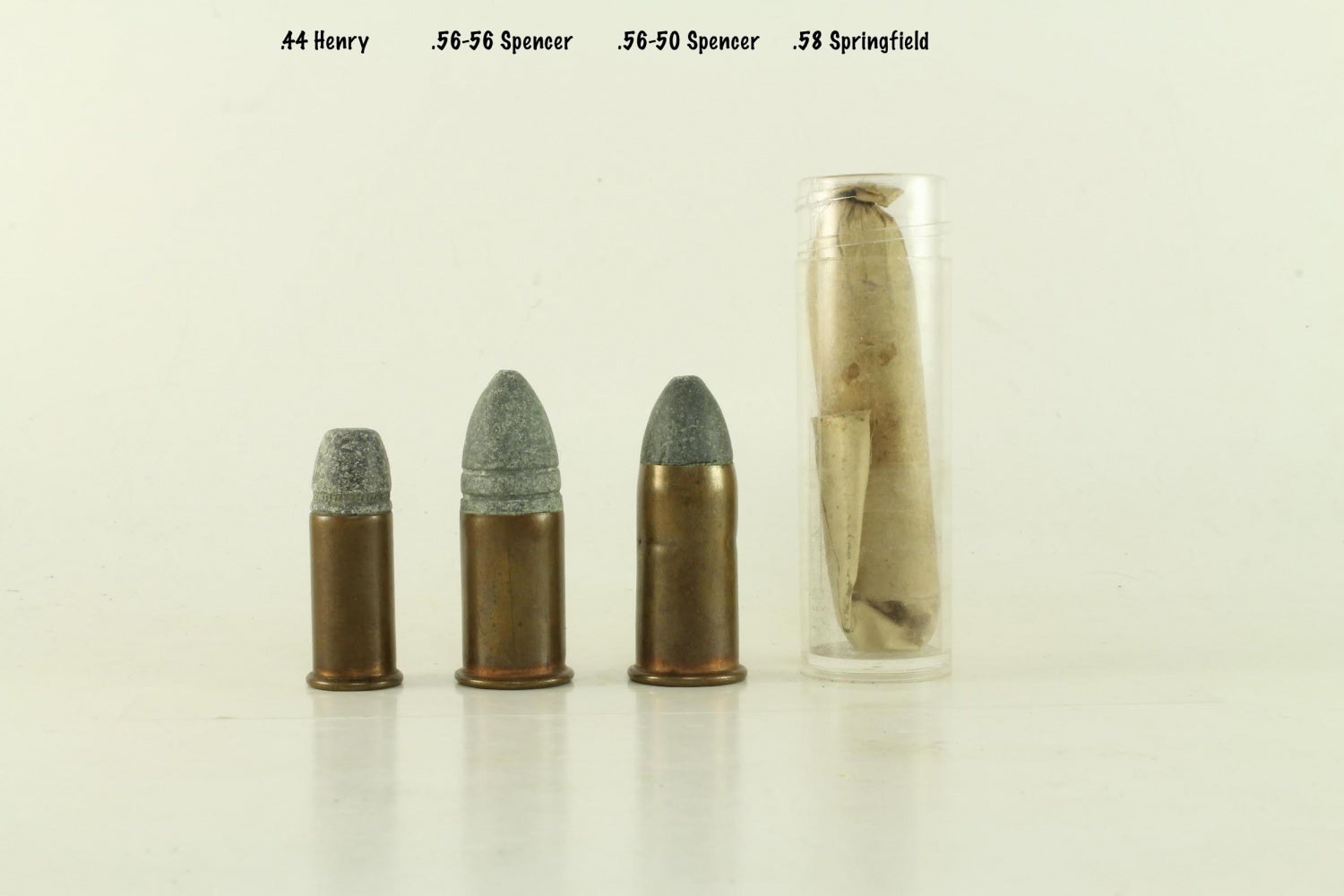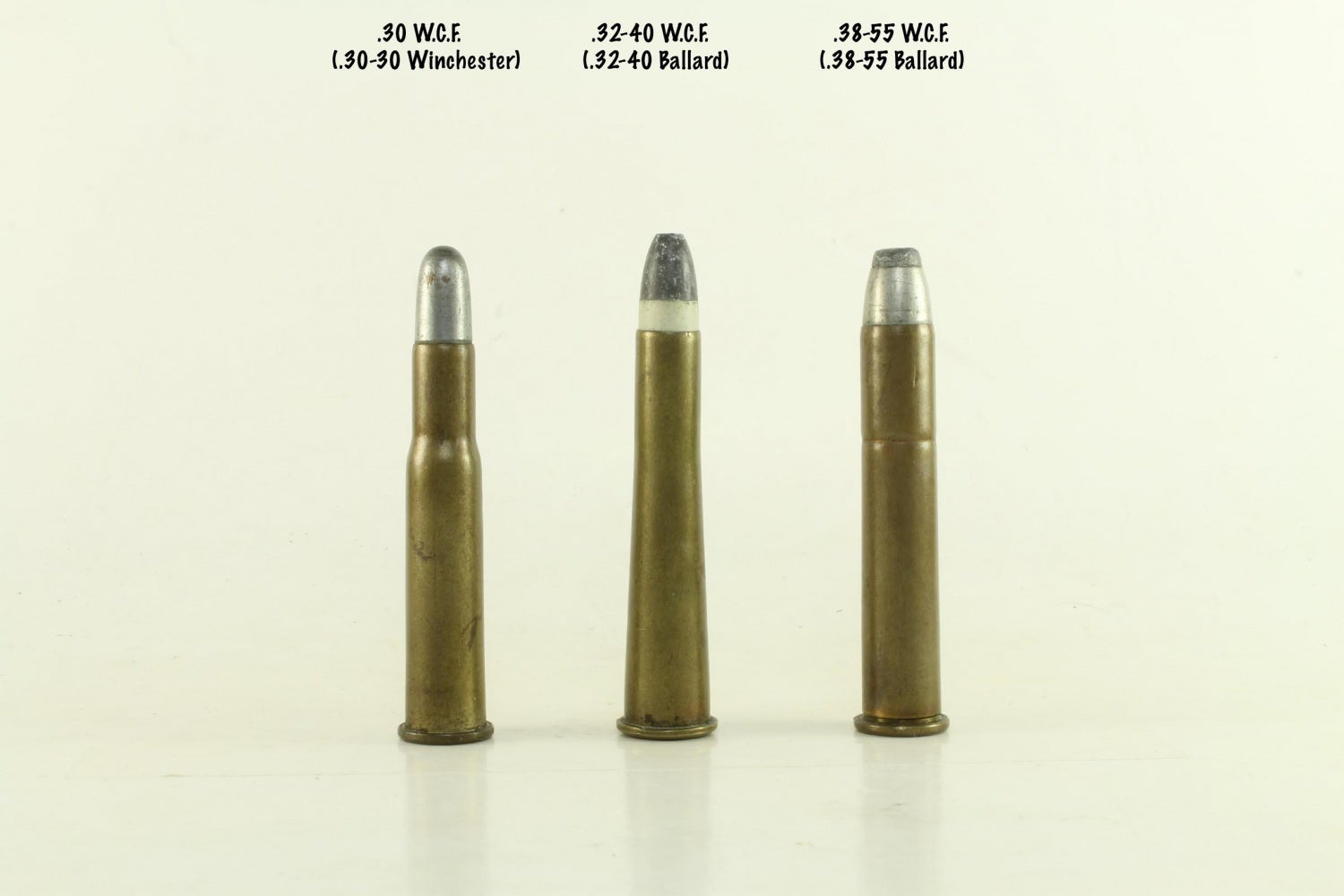What was the first intermediate cartridge? Who designed it, and why? How did the concept evolve? These are all good questions deserving of thorough, thoughtful answers. Sadly, to give a comprehensive history of the intermediate cartridge concept would require a project nearly as long and laborious as my ongoing research project on the Lightweight Rifle program of the 1940s and ’50s, so I won’t do that. Instead, I’d like to take just a brief dip into the long history of the intermediate cartridge, enough to hopefully give my readers an idea of how the concept evolved.
The most famous early intermediate caliber is probably the 7.92×33 “Kurzpatrone” used in the German sturmgewehrs of World War II, but to get a better grasp of how military cartridge development got to that point, we will have to go further back… All the way back, to the dawn of the metallic cartridge era. Prior to the 1860s, the overwhelming majority of firearms were muzzleloading, and the word “cartridge” referred to a device more akin to a speedloader than a self-contained round of ammunition. Soldiers firing muzzleloading weapons like the 1853 Enfield pattern musket would retrieve a cartridge made of paper and loaded with powder and ball, tear it open, dump the powder down the bore of their musket, and then stuff the rest of the cartridge, bullet and all, down the barrel of their weapon with a ramrod. In this context, the concept of an “intermediate” cartridge is less meaningful, as when such an item were ever desired, a soldier could simply put less propellant into his firearm, or even use a pre-loaded round with less propellant in it. For the idea of the intermediate cartridge as we know it now to exist, the metallic cartridge case and the complete self-contained loaded cartridge must first be invented. This innovation occurred gradually until the development of the self-contained rimfire cartridge in the 1840s.
It’s likely impossible to know which cartridge was the first intermediate, for historical as much as definitive reasons, but two of the very earliest would serve with distinction in the American Civil War: The .44 Henry, and the .56-56 Spencer, both rimfire. These two rounds would today be considered closer to magnum handgun rounds than current intermediate cartridges, but in their day they were – in every sense of the word – “intermediate”. Muskets of the day, like the aforementioned 1853 Enfield, gave velocities in the low supersonic range (1,300-1,500 ft/s), with large projectiles wider than half an inch and with weights around an ounce and a quarter (530 grains). The .44 Henry and .56-56 Spencer, in contrast, both gave reduced muzzle velocities of between 1,100 ft/s and 1,200 ft/s, with the former being a lighter round shooting a 200 grain bullet, and the latter firing a heavier 350 grain projectile that nonetheless was still considerably lighter than the full-size Minié balls of the rifled muskets. At the same time, both the Henry and Spencer carbines produced muzzle velocities considerably higher than the pistols and revolvers of the era, which typically fired smaller-caliber bullets at moderate subsonic velocities (600-800 ft/s). Finally, both rounds were designed for weapons giving a massive increase in rapidity of fire over the standard weapons in use by military forces at the time, at the cost of range.
The .44 Henry, despite being less powerful, would end up being the more influential of the two rounds. In 1877, the Ottoman Turks and Imperial Russians were at war, fighting in one of the countless conflicts that dot the bloody timeline of European history during the 19th Century. The Russian Army, along with Romanian allies, had captured the city of Nikopol in Bulgarian, situated on the Danube River. Osman Nuri Pasha, commanding the Ottoman forces, failed to reach Nikopol before the Russians, and instead situated his forces in the nearby town of Pleven, fortifying it. Osman’s forces were equipped not only with Peabody-Martini single-shot rifles, but also with Winchester Model 1866 lever-action repeaters, chambering the .44 Henry cartridge. The Turks, who were widely judged to be in a hopeless position, being outnumbered nearly four-to-one, held the town from 19 July until the 20th of December, in no small part due to the firepower of their repeating Winchester rifles. In the month of September alone, during which the Russians and Romanians mounted a massive assault on Pleven, the attacking forces took approximately 20,000 casualties, while the Turks sustained less than 10,000 dead or wounded.
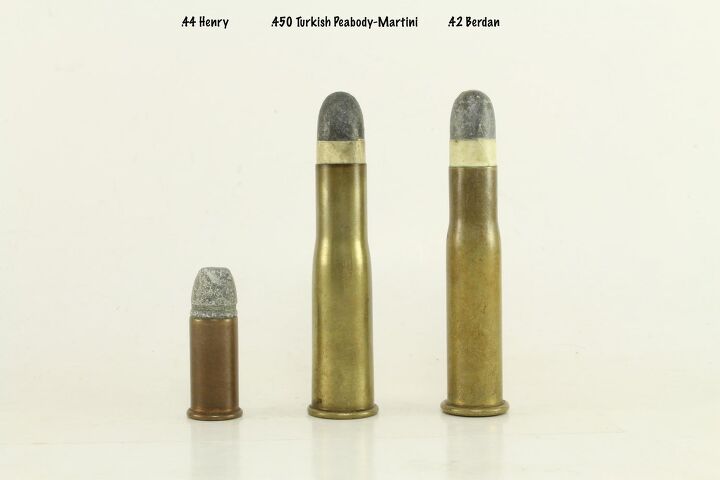
The Russian forces in the Siege of Plevna were armed with Berdan I rifles chambered for 4.2 Line Berdan (.42 Berdan), and Krnka muzzleloading conversions in 6 Line Krnka (.60 Krnka), the former seen here compared to the .44 Henry and .450 Peabody-Martini.
The Siege of Plevna, as it became known, sent shockwaves through the world of infantry small arms. Repeating rifles had proven themselves as a decisive technology, and every military in Europe wanted a new repeating rifle to supplant their single-shot weapons. The intermediate cartridge of the Winchester repeaters, though, would not be adopted by the militiaries of Europe; the Peabody-Martinis at the Siege had likewise proven the value of effective long-range rifle fire. At the time, with no modern support weapons like infantry mortars or machine guns having yet been invented, it was the duty of the rifle to carry the day in long-distance infantry engagements, and the smaller calibers lacked for range. Militiaries sought a new kind of rifle that would combine the deliberate long-range fire capabilities of the Peabody-Martini single-shots with the rapid firepower of the Winchester lever action repeaters. Their solution would be smallbore dual-mode rifles incorporating brand new smokeless powder technology that were capable of operating as either single-shot or repeating arms, and which possessed extremely long range.
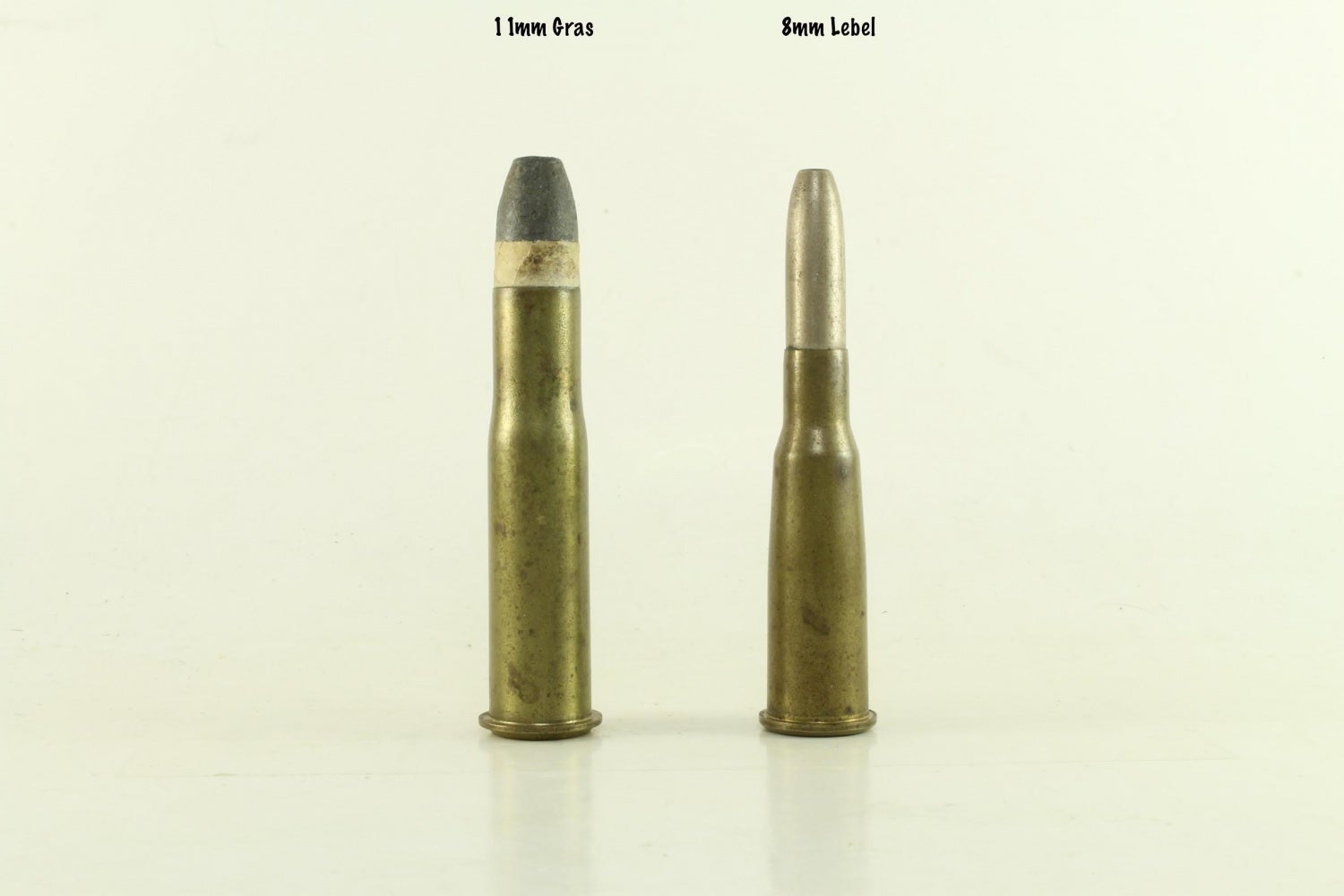
The 8mm Lebel was developed over the course of a few months, based on the 11mm Gras case. While its small-caliber configuration and smokeless powder revolutionized small arms ammunition, the 8mm Lebel quickly became obsolete, and the French Army struggled to replace it until after World War II.
In civilian, law enforcement, and niche military applications, however, the intermediate cartridge would continue its development. In 1894, Winchester introduced a new smokeless powder lever-action repeating rifle, named for that year, in two calibers: The .32-40 and .38-55, both intermediates. In 1895, Winchester announced a strengthened version of the Model 1894 in a new bottlenecked rimmed round that would take the deer hunting world in the United States by storm: The timeless .30 Winchester Center Fire, now more commonly known as the .30-30 Winchester. Winchester’s Model of 1894 and its most famous chambering would even serve in the first World War in limited numbers with Entente forces of multiple nations. In Europe, two firms would experiment with the intermediate cartridge concept: Mannlicher and Mauser, both of which developed semi-automatic carbines chambered for 7.63x32mm Long Mannlicher and 7.63x40mm Long Mauser calibers, respectively. Both of these calibers were relatively low power, however, and still fired round-nosed bullets.
In 1902, Winchester parted ways with firearms design prodigy John Moses Browning over a disagreement regarding the licensing of his long-recoil shotgun patent. Browning took his business over to Remington and FN, the latter of which produced what became the Auto-5 shotgun. Remington eventually licensed a related patent for a semiautomatic rifle, and released the design in 1906 as the Remington Autoloading Rifle, which later was famously renamed the “Model 8”. The Model 8 was chambered for four brand-new cartridges designed from scratch for selfloading rifles: The .25 Remington, .30 Remington, .32 Remington, and .35 Remington. The Model 8 was one of the most significant early selfloading rifles, with examples in .25 caliber being used by the US Army to develop tactics to fully utilize semiautomatics. Almost a hundred years later, the .30 Remington caliber would also serve as the parent for the 6.8mm Remington SPC intermediate cartridge designed for the AR-15.
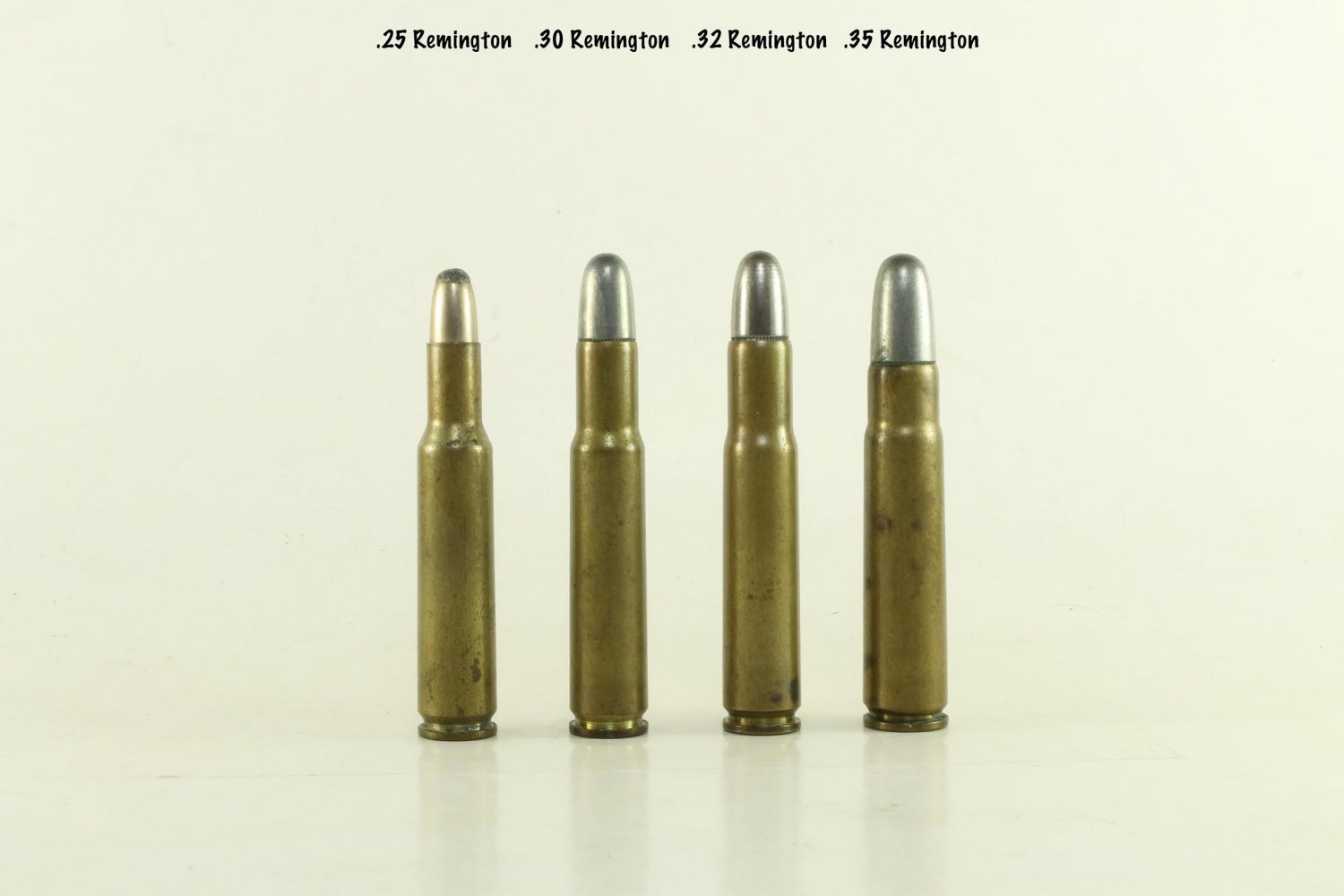
The Remington autoloading cartridges all fall within the modern “intermediate” range for performance, and along with the Model 8 represent an important early stage in the development of the intermediate-cartridge infantry rifle.
Winchester, spurred on by the Model 8, developed a line of selfloading rifles beginning with the rimfire Model 1903. Of the centerfire Model 1905, 1907, and 1910, all chambering semi-rimmed intermediate calibers, it was the 1907 that would be the most successful, and most militarily significant: Like its lever-action stablemate, the Model 1907 would serve with Entente forces during WWI, primarily as a weapon for the nascent flying units of Russia, Great Britain, France (where it was used by both flyers and infantry), and the USA. The .351 Winchester caliber that defined the Model 1907 would become one of the most influential intermediate rounds of all time, being immediately developed into the rimless, spitzer-bullet (one of the first ever in an intermediate caliber) .345 Winchester Machine Rifle in the United States, and the 8mm Ribeyrolle in France, both designed for experimental early assault rifles. After World War I, the .351 served as the basis for a number of other cartridges of varying degrees of obscurity, and the related 8mm Ribeyrolle is even cited by AAC as “foreshadowing” the popular .300 Whisper-derived .300 AAC Blackout, to which it is very similar.
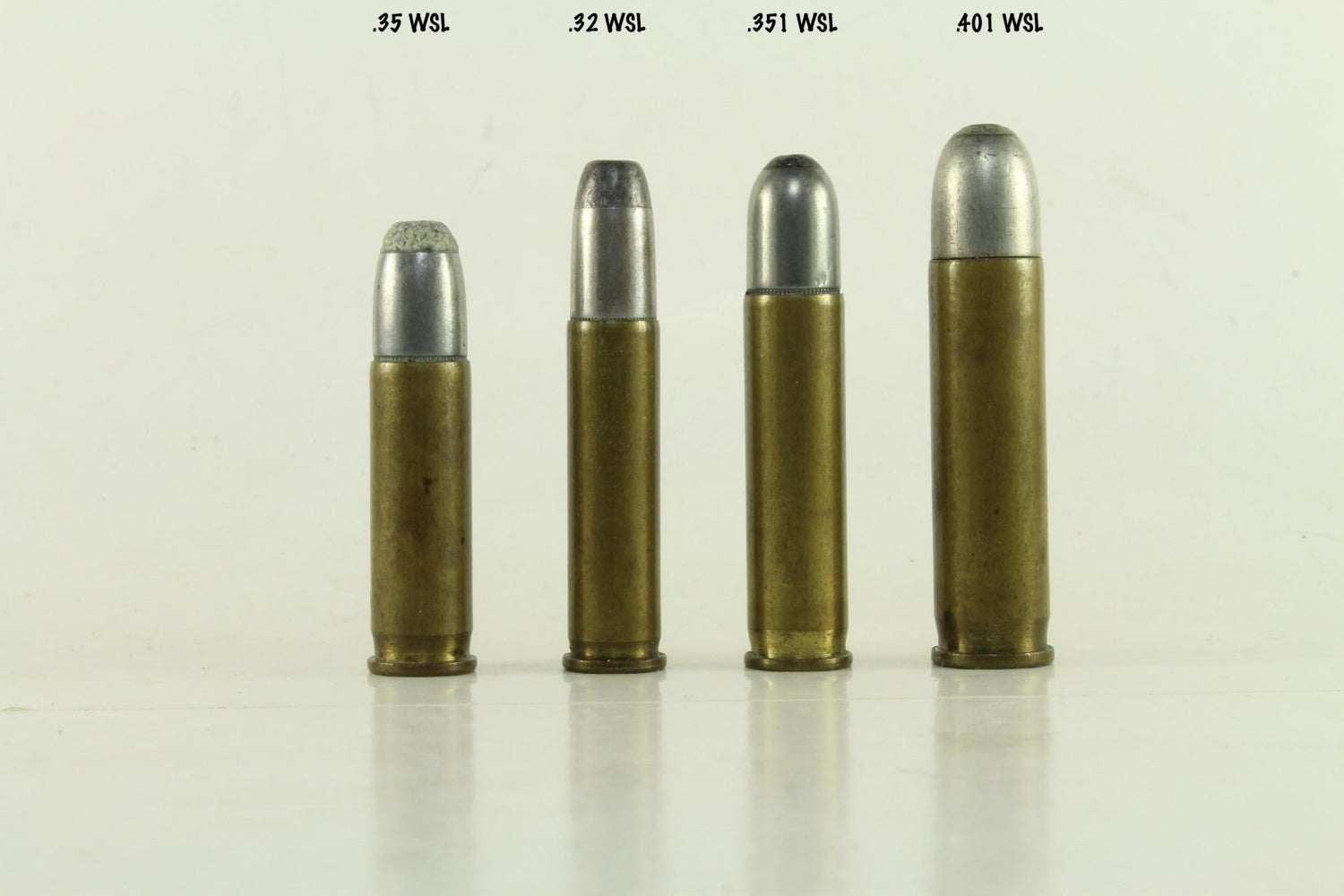
The .351 WSL was an improved version of the .35 WSL, introduced alongside the .32 WSL with the Winchester Model 1905. The .351 WSL was more powerful, and inspired several other early intermediate rounds. In 1910, Winchester introduced the Model 1910, chambered for the yet larger and more powerful .401 WSL.
After the First World War, the military intermediate caliber began to slowly make a comeback. The realities of trench warfare, and the introduction of new weapons like the infantry mortar and machine gun, and the towed howitzer, meant that the rifle was no longer the primary long-range casualty producing weapon on the battlefield. In 1919, a very forward-thinking German First Lieutenant named Piderit who was an assistant to the Gewehrprüfungskommission wrote a memo advocating for a caliber in-between the standard 7.9mm rifle and 9mm pistol cartridges, with an effective range of 400m, for use in an individual automatic weapon. This obscure memo serves as a milestone for the first slip of the grasp of the full-power cartridge’s stranglehold on military cartridge design. After the war, designers from all over Europe began working on new intermediate-caliber rounds that would provide similar killing ability out to the normal direct-fire ranges attained by the rifle or carbine, while being lighter and with lower recoil. Often, these calibers were developed alongside a semiautomatic or select-fire rifle. One very notable line of development occurred in Italy in the 1920s and ’30s. A semiautomatic weapon, the Modelo 1921 Moschetto Automatico per Fanteria (Automatic Musket for Infantry), was chambered for a 7.35x32mm intermediate cartridge based on the 6.5×52 Carcano, firing a 134.5 gr spitzer bullet at 1,970 ft/s. While development of this, and a slightly longer version with a 38mm case apparently ended in the early 1920s, the idea resurfaced in the 1930s under Mussolini’s fascist government, producing a 7.35x41mm round with a semi-round-nosed bullet. This round was lengthened to 51mm to become the 7.35x51mm cartridge, and was adopted by Italy and used during the Second World War. Despite its increased length, the Italian 7.35x51mm cartridge still produced intermediate-type ballistics, firing a 128gr projectile at approximately 2,480 ft/s, very similar to the later 7.62×39 Soviet cartridge, making it the first intermediate adopted as standard issue by a major power.
Many of the calibers developed during this period are mentioned in one of my first articles for this blog, Before The Sturmgewehr: Assault Rifle Developments Prior to 1942, but in addition to those there were a number of notable German developments. The first of these was the 8×42.5mm Rheinmetall-Borsig, designed for a selfloading rifle that was the brainchild of an engineer of that company, Karl Heinemann. This was just the full-size 8mm rifle cartridge cut down and loaded with the 154gr S-Patrone flat-based spitzer bullet, but it foreshadowed the development of the 8x33mm KurzPatrone cartridge of the German sturmgewehrs. Beginning in 1930, the Inspektion der Infanterie (abbreviated “In2”) determined that a unified select-fire infantry weapon would not only allow the German military to circumvent the Treaty of Versailles (which prohibited Germany from producing more submachine guns), but would also give the infantry better effectiveness than a mix of selfloading rifles and light machine guns. In2 tasked RWS with creating such an “ideal” intermediate caliber, and that company developed as a result an 8.15x46mm caliber, probably based on their earlier 7x46mm designed for aircraft guns, but no weapon was apparently designed to fire it. Rheinmetall-Borsig also developed their own intermediate, a very compact 7×36.5mm caliber firing a 139gr bullet at 2,300 ft/s from a 13.9″ barrel, which, like the RWS round, remained a ballistic test cartridge only. More successful was the DWM effort, a 7×39.1mm round which did see testing in a Mauser-designed select-fire carbine. The German efforts to produce an intermediate round and a select-fire rifle to fire it would continue until their final success with the MP.43 – later redesignated StG.44 – being fielded in large numbers during World War II.
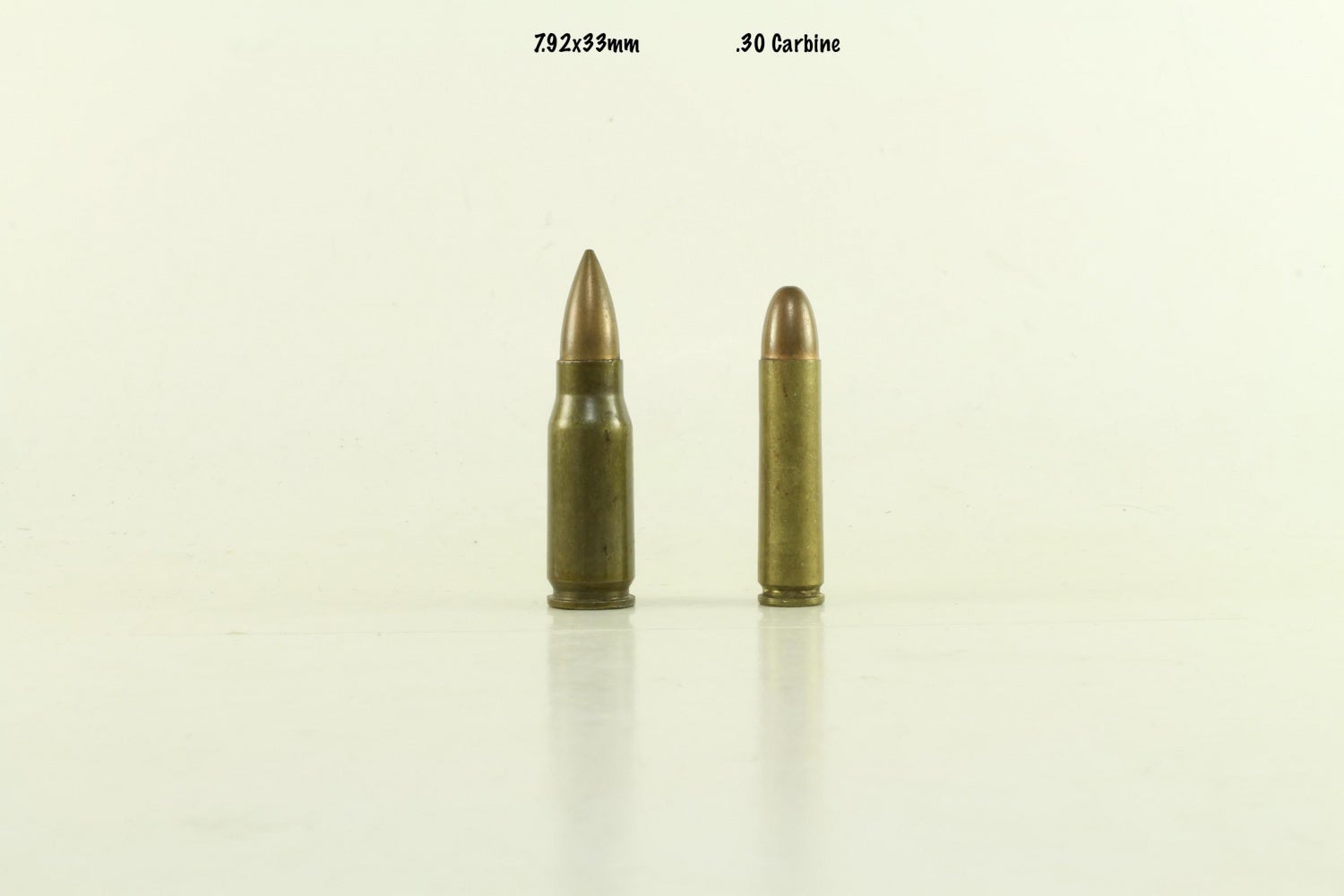
During World War II, the semiautomatic and select-fire intermediate caliber weapon finally had its day, with the United States first introducing the semiautomatic M1 Carbine in a .30 caliber round of the same name in 1941. In 1942, the Nazi Germans introduced an open-bolt select-fire rifle in a shortened 7.92x33mm caliber, the MKb.42(H), later improved to the closed-bolt MP.43 the next year. In 1944, the United States introduced a select-fire version of their Carbine, the M2. The Russians would also introduce an intermediate caliber, the 7.62x41mm M43, upon encountering the MKb.42(H) in combat, which later was improved to the 7.62x39mm caliber of the ubiquitous SKS and AK families of rifles.
It would be awkward not to mention one final development in intermediate cartridges, at the very beginning of World War II. In the late 1930s, the US Army Ordnance Department was given the task by the Infantry Board to develop a small, lightweight carbine that could replace the handgun in use with echelon troops. As a necessity, a new round had to be developed that would facilitate the smallest and lightest weapon possible, and Ordnance brought in the help of Winchester Repeating Arms to design such a caliber. They recommended a rimless .30 caliber version of the semi-rimmed .32 WSL introduced with the aforementioned Model 1905 selfloading rifle. By October, a preliminary sketch of the caliber that became the .30 cal M1 Carbine was drawn up. Incidentally, it was Winchester’s rifle entry into the competition that won, becoming the famous M1 Carbine.
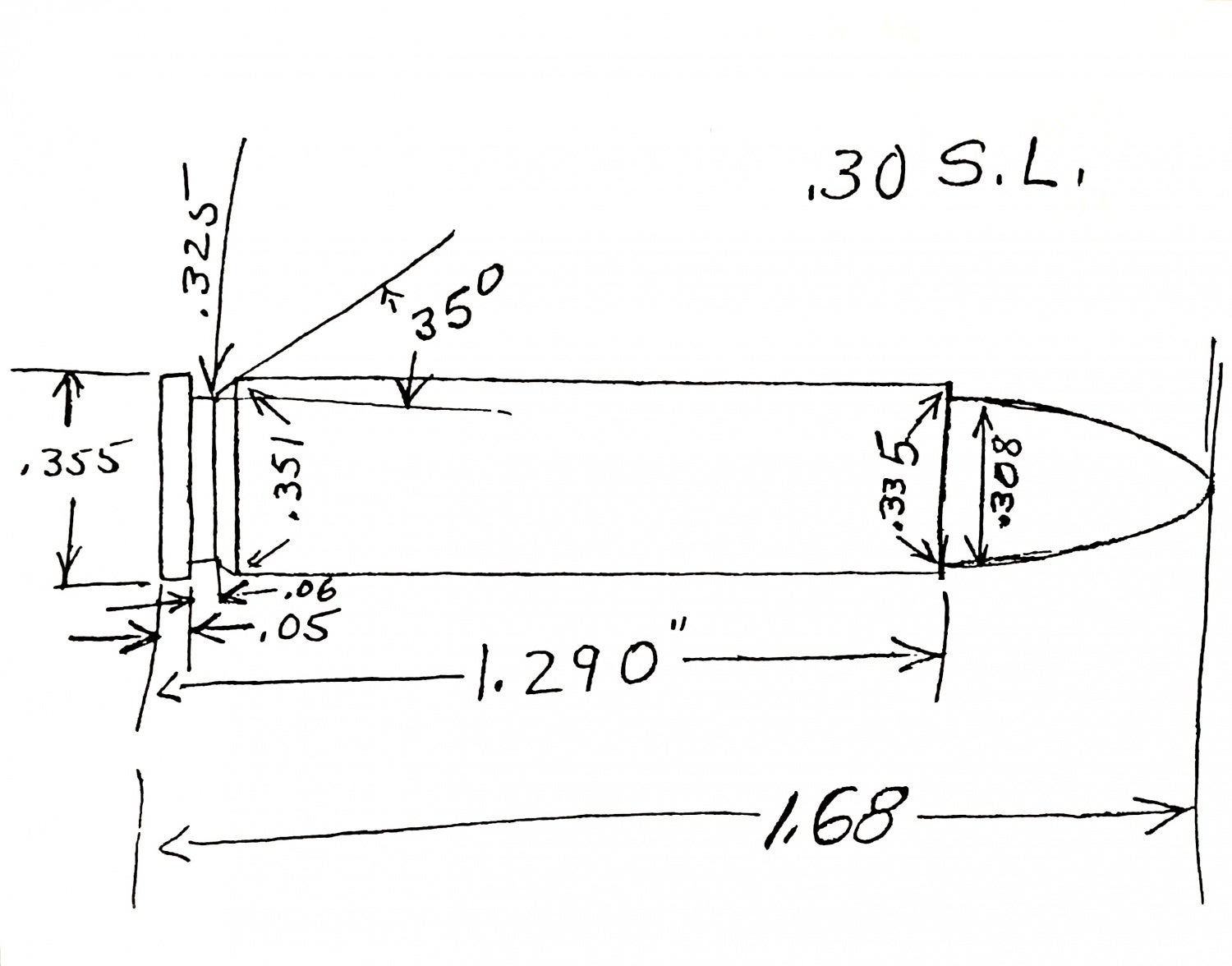
The original drawing for the “.30 SL” rimless variant of the .32 SL cartridge, designed by Winchester. This was the prototype for the cartridge that would be adopted as the .30 cal. M1 Carbine.
The development of intermediate calibers before 1943 is an extensive subject, and I have only written the most cursory overview of it here. Hopefully, though, I have made more visible some of the remarkable developments that occurred before the Second World War.
A big hearty thank you to DrakeGmbH for his assistance with this article. All the photos in this article are his, used with permission.
 Your Privacy Choices
Your Privacy Choices

